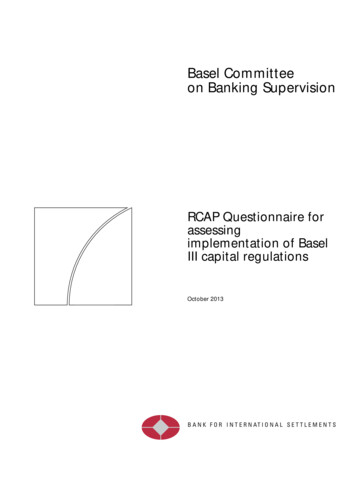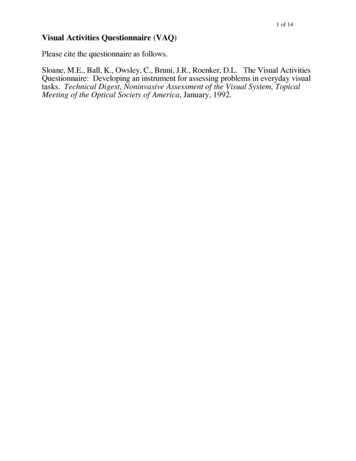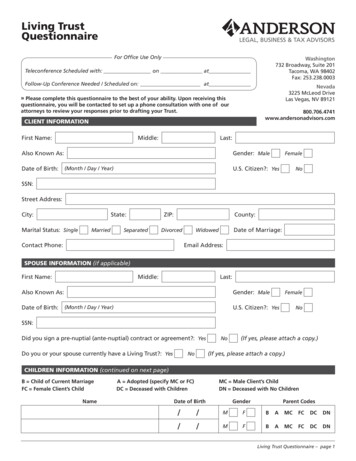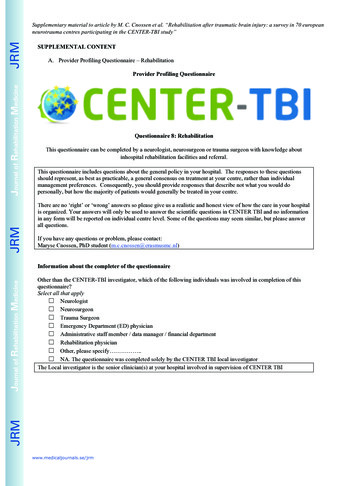
Transcription
Basel Committeeon Banking SupervisionRCAP Questionnaire forassessingimplementation of BaselIII capital regulationsOctober 2013
This publication is available on the BIS website (www.bis.org). Bank for International Settlements 2013. All rights reserved. Brief excerpts may be reproduced ortranslated provided the source is stated.In case you wish to obtain the Word version of this document please send your request to:BCBS.Implementation@bis.org.
ContentsQuestionnaire for assessing implementation of Basel III capital regulations . 1Data collection. 2Reference and supporting documents . 4RCAP questionnaire . 6Section 1 . 7General questions . 7Overview of self-evaluation . 7Section 2 . 9A. Basel II capital requirements . 91. Introduction . 92. Scope of application . 93. The First Pillar – minimum capital requirements . 114. The Second Pillar – Supervisory Review Process . 595. Supplemental Pillar 2 Guidance (Supervisory Review Process) . 656. The Third Pillar – Market discipline . 667. Treatment of counterparty credit risk and cross-product netting (Annex 4) . 71B. Basel III capital requirements . 798. Definition of capital . 799. Risk coverage . 8710. Capital conservation buffer . 8811. Countercyclical capital buffer . 9012. Minimum requirements to ensure loss absorbency at the point of non-viability . 9113. Pillar 3 Disclosure requirements for remuneration . 9314. Disclosure requirements for capital . 94Section 3 . 97Data tables . 97Bank-specific data to be submitted along with RCAP questionnaire . 97Overview of the banking sector of the jurisdiction . 100RCAP Questionnaire for assessing implementation of Basel III capital regulations
Questionnaire for assessing implementation of Basel III capitalregulationsGuidance to respondentsAll sections of the questionnaire should be completed in English. References to domestic regulations andspecific regulatory texts that implement the Basel provisions should be as detailed as possible. Additionalsheets and associated documents can be appended to the questionnaire to help provide furtherexplanation and background information to the assessment team.RCAP is a comprehensive programme introduced by the Basel Committee in 2012 to assessits members’ implementation of Basel II, 2.5 and III.1 The objective of the assessment programme is tohelp member jurisdictions ensure full, timely and consistent implementation of Basel framework. Theaim is to strengthen the global banking system, maintain market confidence in regulatory ratios, andpromote a level playing field.Scope of the questionnaireA major component of the RCAP involves the assessment of how far domestic regulations areconsistent with the corresponding standards under the Basel framework.This questionnaire covers the full set of Basel risk-based capital standards as laid down inBasel II and amended by Basel 2.5 and Basel III.2 Other standards will be included in the assessmentswhen the due dates for their implementation arrive.3Structure of the questionnaireIn the preparatory phase of its RCAP assessment, the assessed jurisdiction reports on its compliancewith the Basel framework. The completed questionnaire is used by the assessment team to form initialimpressions about the degree of compliance and serves as the basis for further assessment workincluding an assessment of the materiality of any identified differences.The main aim of this RCAP questionnaire is therefore to map the domestic capital regulationsto the Basel provisions and to help the assessed jurisdiction to identify any deviations of domesticregulations from the Basel standards. The RCAP questionnaire has three parts: Part 1 contains anumber of general questions and asks for system-level data on financial soundness and Basel IIIimplementation; Part II deals with capital regulations; while Part III provides the data requirements.1See also Basel Committee on Banking Supervision, Basel III regulatory consistency assessment programme, April 2012,www.bis.org/publ/bcbs216.pdf.2The assessments under the RCAP will progressively include the liquidity standards, the G-SIB and D-SIB standards and theleverage ratio.3For phase-in arrangements see Annex 4 of Basel Committee on Banking Supervision, Basel III: A global regulatoryframework for more resilient banks and banking systems, June 2011, www.bis.org/publ/bcbs189.pdf.RCAP Questionnaire for Basel III Implementation1
Data collectionDomestic regulations are graded for their compliance with the Basel standards according to themateriality of any deviations from the standards. The materiality of deviations is measured in terms oftheir impact on capital ratios and, where relevant, on risk-weighted assets. The impact is quantifiedwith the help of data submitted by the supervisory authority.For each identified deviation, the RCAP questionnaire asks for bank-specific data to supportthe analysis of materiality. The data would normally relate to the amount of exposure or EAD impactedby the deviation, impact on RWAs and, finally, impact on capital ratios. Wherever necessary, the datashould be submitted both in absolute and relative terms (for example, relative to the total balancesheet of the bank, or the total banking sector, so that the team can make an assessment of itsmateriality). The data should reflect the full implementation of the Basel capital regulations and shouldnot take into account phase-in arrangements. Where local regulations are assessed to be in line withthe Basel rules, there is no requirement to provide data. Likewise, where the domestic regulationsimpose requirements on banks over and above the requirements in the Basel text, the provision ofsupporting data is optional.Data collection phasesTo facilitate the collection of meaningful data and related information early in the preparatory phase,the assessed jurisdictions are encouraged to provide a first set of bank-level data regarding the gapsidentified in the RCAP questionnaire (please see the Data Tables provided at the end of thequestionnaire). 4 In addition, the assessed jurisdiction is requested to submit high-level data onfinancial indicators regarding its banking sector, and other relevant studies and reports, which serve asbackground information for the assessment team.The RCAP team may submit additional data/information request(s) following its examinationof the questionnaire (together with any other requests for clarifications). The experience thus far showsthat the amount of follow-up data requested has been far more than the data received along with theRCAP questionnaire.Since the time available for follow-up data collection is generally shorter than that for initialdata collection, it would be very helpful if the assessed jurisdictions gave careful thought to identifyingany deviations when completing the RCAP questionnaire and collecting the associated data during theinitial phase itself.Guiding principles for data collectionTo ensure a meaningful assessment, the following principles should guide data collection for RCAPpurposes as well as for later use by the assessed jurisdictions:1.42In completing the questionnaire, the respondents should generally aim to collect data for allidentified gaps that are quantifiable, regardless of their perceived materiality. A properevaluation of materiality is key to the RCAP assessment.The usual confidentiality level used by the Secretariat will apply and is documented by means of confidentialityagreements. This data should be submitted in Excel format using the templates especially provided for the purpose.RCAP Questionnaire for Basel III Implementation
2.The burden of proof lies with the member jurisdiction to show that a finding is not material orpotentially so. Where the assessed jurisdiction is unable to provide quantitative data, it shoulddemonstrate otherwise that the gap is not material or not potentially so.3.Data requests should be driven by the specific identified gaps. An early finalisation of thepreliminary list of gaps would help to streamline the data-gathering process. Activeconsultation with the assessed jurisdiction prior to the on-site visit(s) is essential to reduce thedata-related pressure on the assessed jurisdictions.Types of dataBroadly speaking, the following data should be used to assess the materiality of gaps:1.Granular, bank-specific data that would allow for a direct estimate of the impact of gaps onreported capital ratios.2.Less granular, non-bank specific data that would indirectly provide quantitative evidence ofthe materiality of a gap. Examples include aggregated data on outstanding instruments,nominal exposure data, market sizes, trading volumes etc.3.Qualitative information that would indirectly support the materiality assessment. Typically, theinterpretation of this type of data would rely more heavily on expert judgment. Examplesinclude information on the importance of certain banking activities, or written qualitativestatements from banks regarding the materiality of certain activities or exposures on theirbalance sheet.Ideally, the materiality of gaps will be assessed based on bank-specific data that allow for adirect impact assessment.Implementation of the advanced approachesIt should be noted that certain jurisdictions may choose not to adopt some or all of the advancedapproaches of the Basel III framework for the measurement of risks. Such choices are not deemed tobe deviations for the purpose of assessment; the relevant provisions will be considered as nonapplicable, in line with the approach adopted by the Committee when developing Basel II.5National discretionsWhere the Basel documents provide for national discretions, member jurisdictions are asked toindicate whether and to what extent they have exercised these discretions, or propose to exercisethem. For the purpose of the assessment, the exercise of such national discretions will not beconsidered a deviation. However, national discretions that are not provided for in the Basel documentsand result in weakening of the implementation of the Basel standards in the local jurisdictions will beconsidered deviations for the purpose of the assessment. Further, jurisdictions are also asked toprovide details where they have imposed stricter requirements than those required by the Baselstandards. Such measures are fully in line with the nature of the international agreements, which are5Paragraph 7 of the Basel II document and its Simplified Standardised Approach in Annex 11 show the Committee’sintention to provide a range of options to allow supervisors to select approaches that are most appropriate for theirfinancial market infrastructure.RCAP Questionnaire for Basel III Implementation3
intended to set minimum requirements, and will therefore be considered as compliant. However, theywill not be considered as compensating for inconsistencies or gaps identified elsewhere.Reference and supporting documentsThe list of Basel documents that are in scope of the assessment are listed below. In addition to thecompleted questionnaire response, jurisdictions are asked to provide certain documents, as indicatedin this section, that are meant to facilitate and support the work of the assessment team.List of Basel documents relevant to the assessment6The following list provides an overview of the Basel documents that are in scope of the assessment. Itmay be noted that the published Basel press releases or FAQs that clarify the interpretation ofpublished Basel II, 2.5 and III documents are also within the scope of this assessment. Further, annexesreferred to in the Basel documents are also within the scope of the assessment.1.Basel II: International convergence of capital measurement and capital standards: a revisedframework – comprehensive version (June 2006).2.Enhancements to the Basel Framework (July 2009).3.Guidelines for computing capital for incremental risk in the trading book (July 2009).4.Final elements of the reforms to raise the quality of regulatory capital issued by the BaselCommittee (January 2011).5.Revisions to the Basel II market risk framework – updated as of 31 December 2010 (February2011).6.Basel III: A global regulatory framework for more resilient banks and banking systems –revised version (June 2011).7.Pillar 3 Disclosure requirements for remuneration (July 2011).8.Treatment of trade finance under the Basel capital framework (October 2011).9.Interpretive issues with respect to the revisions to the market risk framework (November2011).10.Composition of capital disclosure requirements – Rules text (June 2012).11.Capital requirements for bank exposures to central counterparties (July 2012).12.Regulatory treatment of valuation adjustments to derivative liabilities: final rule issued by theBasel Committee (July 2012).13.FAQs published by the Committee including those that would solve any interpretative issuearising during the assessment.76See also www.bis.org/bcbs/basel3/compilation.htm. Regulatory compliance with Basel standards that are not yet finalisedwill be subject to follow-up assessments at a later stage.7Eg Basel III counterparty credit risk – Frequently asked questions, November 2012; Basel III definition of capital – Frequentlyasked questions, December 2011.4RCAP Questionnaire for Basel III Implementation
Supporting documents to be submitted by the assessed jurisdictionsIn addition to the completed questionnaire, respondents are asked to provide the followingdocuments:1.The domestic regulations that implement Basel II, 2.5 and III, independent of their form andnature, which are referenced in the answer to the self-assessment questionnaire. Thedomestic regulation should be transmitted in both its official language and Englishtranslation.2.Evaluation reports: copies of the most recent internal, external or third-party assessments thatcover capital adequacy regulation. Only the relevant part of these documents needs to beprovided.3.Other documents: any other documents that provide information about the context,conditions or nature of Basel implementation (eg public statements, studies, impact analyses,policy papers) and could usefully inform the assessment team. These documents could bepublic documents or internal/working documents.RCAP Questionnaire for Basel III Implementation5
RCAP questionnaireThe questionnaire is organised in three sections: Section 1 contains general questions and a summary of the self-evaluation; Section 2 contains a paragraph-by-paragraph evaluation of domestic regulations withreference to the corresponding capital standards under the Basel framework; and Section 3 contains tables for data collection.Section 2 is further divided into two broad subsections – Basel II and Basel III. The provisionsof Basel 2.5 and Basel III which amend the Basel II risk-weighted assets framework and Pillar 2 havebeen merged in the respective parts of the Basel II subsection. However, the provisions of Basel IIIwhich amend the definition of capital and Pillar 3 under Basel II remain part of the Basel III subsection.6RCAP Questionnaire for Basel III Implementation
Section 1General questionsDateCountryDomestic regulations implementing Basel II (version anddate)Domestic regulations implementing Basel 2.5 (versionand date)Domestic regulations implementing Basel III (version anddate)(1) Please explain which authorities will implement Basel III and their respective responsibilities.(2) Please explain background of regulations to be assessed, ie whether regulations are draft or final, internal or public, andwhether text in English is available. If regulations are yet to be drafted, please give timescales.(3) If the final rules are in place, please explain their legal status? Are they legally binding on firms?(4) If the rules are currently in draft or yet to be drafted, please explain their likely legal status once adopted. Is this still amatter for discussion at the national level?(5) Are the regulations supplemented by additional guidance? What are the legal status of the guidance and theconsequences of firms not meeting the guidance?(6) Please explain the scope of firms subject to the regulations above. If applicable, please clarify the types of institutions (iebanks and/or investment firms) and whether they represent a subset of the total population (ie only large or internationallyactive banks ).(7) Please explain the timetable for adoption of the above regulations. It is not necessary to repeat information provided aspart of the SIG Level 1 assessment process. Please comment only where there have been any changes or where greaterclarification is necessary.Overview of self-evaluation(1) Please summarise your opinion of whether in aggregate you believe the regulations defined above are compliant, largelycompliant, materially non-compliant, or non-compliant with Basel II, II.5 and III. Please include an explanation/justification ofyour opinion.(2) Please comment on the main areas of difference.RCAP Questionnaire for Basel III Implementation7
(3) Please provide a short summary of the rationale for the main areas of difference (more detailed points are addressedlater in the questionnaire).(4) Please comment on your assessment of the materiality of the areas of difference for the internationally active banks inyour jurisdiction.8RCAP Questionnaire for Basel III Implementation
Section 2A. Basel II capital requirementsReference BCBSdocumentInternational Convergence of Capital Measurement andCapital Standards, June 2006 (Basel II) as amendedby Basel 2.5 and III1. IntroductionParagraphs 1–15 do not contain any specific requirements.N/AParagraph 16 (including footnote 3)Do the domestic regulations implement the requirements of the aboveparagraph(s) in full? Please only answer yes if fully implemented; if partiallyimplemented then answer no. If domestic regulations are more rigorous orimpose additional requirements to Basel minimum please answer “additionalrequirements”.Yes/No/Additional requirementsPlease give the specific reference in the domestic regulations to theserequirements.Please list any differences that do not fully implement, or could be viewed asnot fully implementing, the requirements of the above paragraphs.Please explain the rationale for each of the differences listed. Please be asspecific as possible to help the assessors understand the particular domesticcircumstances.Where there are differences, please provide an assessment of the impact in theattached spreadsheet.See attached spreadsheetParagraphs 17–19(i)Paragraphs do not contain any specific requirements.N/A2. Scope of applicationParagraphs 20–23: IntroductionDo the domestic regulations implement the requirements of the aboveparagraph(s) in full? Please only answer yes if fully implemented; if partiallyimplemented then answer no. If domestic regulations are more rigorous orimpose additional requirements to Basel minimum please answer “additionalrequirements”.Yes/No/Additional requirementsPlease give the specific reference in the domestic regulations to theserequirements.Please list any differences that do not fully implement, or could be viewed asnot fully implementing, the requirements of the above paragraphs.Please explain the rationale for each of the differences listed. Please be asspecific as possible to help the assessors understand the particular domesticcircumstances.Paragraphs 24–27: Banking, securities and other financial subsidiariesParagraphs 24Do the domestic regulations implement the requirements of the aboveparagraph(s) in full? Please only answer yes if fully implemented; if partiallyimplemented then answer no. If domestic regulations are more rigorous orimpose additional requirements to Basel minimum please answer “additionalrequirements”.Yes/No/Additional requirementsPlease give the specific reference in the domestic regulations to theseRCAP Questionnaire for Basel III Implementation9
requirements.Please list any differences that do not fully implement, or could be viewed asnot fully implementing, the requirements of the above paragraphs.Please explain the rationale for each of the differences listed. Please be asspecific as possible to help the assessors understand the particular domesticcircumstances.Paragraph 25 as amended by the revised framework8Do the domestic regulations implement the requirements of the aboveparagraph(s) in full? Please only answer yes if fully implemented; if partiallyimplemented then answer no. If domestic regulations are more rigorous orimpose additional requirements to Basel minimum please answer “additionalrequirements”.Yes/No/Additional requirementsPlease give the specific reference in the domestic regulations to theserequirements.Please list any differences that do not fully implement, or could be viewed asnot fully implementing, the requirements of the above paragraphs.Please explain the rationale for each of the differences listed. Please be asspecific as possible to help the assessors understand the particular domesticcircumstances.Paragraphs 26–27Do the domestic regulations implement the requirements of the aboveparagraph(s) in full? Please only answer yes if fully implemented; if partiallyimplemented then answer no. If domestic regulations are more rigorous orimpose additional requirements to Basel minimum please answer “additionalrequirements”.Yes/No/Additional requirementsPlease give the specific reference in the domestic regulations to theserequirements.Please list any differences that do not fully implement, or could be viewed asnot fully implementing, the requirements of the above paragraphs.Please explain the rationale for each of the differences listed. Please be asspecific as possible to help the assessors understand the particular domesticcircumstances.Paragraph 28 and 29: Significant minority investments in banking, securities and other financial entitiesParagraph 28 as amended by the revised framework9Do the domestic regulations implement the requirements of the aboveparagraph(s) in full? Please only answer yes if fully implemented; if partiallyimplemented then answer no. If domestic regulations are more rigorous orimpose additional requirements to Basel minimum please answer “additionalrequirements”.Yes/No/Additional requirementsPlease give the specific reference in the domestic regulations to theserequirements.Please list any differences that do not fully implement, or could be viewed asnot fully implementing, the requirements of the above paragraphs.Please explain the rationale for each of the differences listed. Please be asspecific as possible to help the assessors understand the particular domesticcircumstances.8Paragraph 25 amended by Basel III (Paragraphs 62–65).9Paragraph 28 amended by the Basel III package.10RCAP Questionnaire for Basel III Implementation
Paragraph 29 as amended by the revised framework10Do the domestic regulations implement the requirements of the aboveparagraph(s) in full? Please only answer yes if fully implemented; if partiallyimplemented then answer no. If domestic regulations are more rigorous orimpose additional requirements to Basel minimum please answer “additionalrequirements”.Yes/No/Additional requirementsPlease give the specific reference in the domestic regulations to theserequirements.Please list any differences that do not fully implement, or could be viewed asnot fully implementing, the requirements of the above paragraphs.Please explain the rationale for each of the differences listed. Please be asspecific as possible to help the assessors understand the particular domesticcircumstances.Paragraphs 30–34 : Insurance entities11Paragraphs 35–36 to the extent not modified by the Basel III package:12 Significant investments in commercialentitiesDo the domestic regulations implement the requirements of the aboveparagraph(s) in full? Please only answer yes if fully implemented; if partiallyimplemented then answer no. If domestic regulations are more rigorous orimpose additional requirements to Basel minimum please answer “additionalrequirements”.Yes/No/Additional requirementsPlease give the specific reference in the domestic regulations to theserequirements.Please list any differences that do not fully implement, or could be viewed asnot fully implementing, the requirements of the above paragraphs.Please explain the rationale for each of the differences listed. Please be asspecific as possible to help the assessors understand the particular domesticcircumstances.Paragraphs 37–39 : Deduction of investments pursuant to this part133. The First Pillar – minimum capital requirementsI. Calculation of minimum capital requirements (Paragraphs 40–49)Paragraphs 40–41 : Regulatory capitalParagraphs have been superseded by the Basel III packageN/A14Paragraph 42 : General provisionsParagraph 43 to the extent not modified by the Basel III package:15 IRB EL deductionsDo the domestic regulations implement the requirements of the aboveparagraph(s) in full? Please only answer yes if fully implemented; if partiallyimplemented then answer no. If domestic regulations are more rigorous orimpose additional requirements to Basel minimum please answer “additionalrequirements”.10Paragraph 29 is amended by Basel III.11Superseded by Basel III.12Include relevant aspects to the extent not superseded by the Basel III package.13Superseded by Basel III.14Superseded by Basel III.15Include relevant aspects to the extent not superseded by the Basel III package.RCAP Questionnaire for Basel III ImplementationYes/No/Additional requirements11
Please give the specific reference in the domestic regulations to theserequirements.Please list any differences that do not fully implement, or could be viewed asnot fully implementing, the requirements of the above paragraphs.Please explain the rationale for each of the differences listed. Please be asspecific as possible to help the assessors understand the particular domesticcircumstances.Where there are differences, please provide an assessment of the impact in theattached spreadsheet.See attached spreadsheetParagraph 44 : Risk-weighted assetsDo the domestic regulations implement the requirements of the aboveparagraph(s) in full? Please only answer yes if fully implemented; if partiallyimplemented then answer no. If domestic regulations are more rigorous orimpose additional requirements to Basel minimum please answer “additionalrequirements”.Yes/No/Additional requirementsPlease give the specific reference in the domestic regulations to theserequirements.Please list any differences that do not fully implement, or could be viewed asnot fully implementing, the requirements of the
RCAP Questionnaire for Basel III Implementation 1 Questionnaire for assessing implementation of Basel III capital regulations Guidance to respondents All sections of the questionnaire should be completed in English. References to domestic regulations and specific regulatory texts that implement the Basel provisions should be as detailed as .










